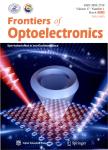Generation and detection of pulsed terahertz waves in gas: from elongated plasmas to microplasmas
Generation and detection of pulsed terahertz waves in gas: from elongated plasmas to microplasmas作者机构:The Institute of Optics University of Rochester Rochester NY 14627 USA State Key Laboratory of IndustrialControl Technology College of Control Science and Engineering Zhejiang University Hangzhou 310027 China The Beijing Advanced Innovation Center for Imaging Technology Capital Normal University Beijing 100037 China
出 版 物:《Frontiers of Optoelectronics》 (光电子前沿(英文版))
年 卷 期:2018年第11卷第3期
页 面:209-244页
核心收录:
学科分类:0810[工学-信息与通信工程] 08[工学] 09[农学] 081001[工学-通信与信息系统] 0901[农学-作物学]
基 金:sponsored by the National Science Foundation the Army Research Office Part of the research in Zhejiang University (ZJU) 国家自然科学基金
主 题:terahertz waves Terahertz Air Photonics generation and detection elongated plasmas microplasmas
摘 要:The past two decades have seen an exponential growth of interest in one of the least explored region of the electromagnetic spectrum, the terahertz (THz) frequency band, ranging from to 0.1 to 10 THz. Once only the realm of astrophysicists studying the background radiation of the universe, THz waves have become little by little relevant in the most diverse fields, such as medical imaging, industrial inspection, remote sensing, fundamental science, and so on. Remarkably, THz wave radiation can be generated and detected by using ambient air as the source and the sensor. This is accomplished by creating plasma under the illumination of intense femtosecond laser fields. The integration of such a plasma source and sensor in THz time-domain techniques allows spectral measurements covering the whole THz gap (0.1 to 10 THz), further increasing the impact of this scientific tool in the study of the four states of matter. In this review, the authors introduce a new paradigm for implementing THz plasma techniques. Specifically, we replaced the use of elongated plasmas, ranging from few mm to several cm, with sub-mm plasmas, which will be referred to as microplasmas, obtained by focusing ultrafast laser pulses with high numerical aperture optics (NA from 0.1 to 0.9). The experimental study of the THz emission and detection from laser-induced plasmas of submillimeter size are presented. Regarding the microplasma source, one of the interesting phenomena is that the main direction of THz wave emission is almost orthogonal to the laser propagation direction, unlike that of elongated plasmas. Perhaps the most important achievement is the demonstra- tion that laser pulse energies lower than 1 μJ are sufficientto generate measurable THz pulses from ambient air, thus reducing the required laser energy requirement of two orders of magnitude compared to the state of art. This significant decrease in the required laser energy will make plasma-based THz techniques more accessible to the



